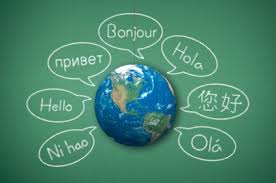This blog entry is the start of a 6 or 7 (or 8?) part series over the next week or two describing what a curriculum for human languages literacy might look like.
What do I mean by the term language literacy or languages literacy? We generally understand “literacy” to be about the ability to read, about being able to read and write. But we’ve also coined a number of other literacy related terms. Computer literacy, cultural literacy and financial literacy are just a few examples.  To be literate in these different topics is to have a basic understanding about the subject in general and be able to apply this understanding in at least a rudimentary way. By using the term “literacy,” it can also be implied that these different subjects are important to know about for individuals to function well in today’s society. That is, the implication is that most everyone should have a basic understanding of how to use a computer. Most everyone should grasp important aspects of our heritage and culture and (hopefully) other cultures as well. Most everyone should have a basic understanding of how personal finances work. Certainly, the person who is literate in these different areas will be better prepared to manage their daily activities and be a contributing member of their community.
To be literate in these different topics is to have a basic understanding about the subject in general and be able to apply this understanding in at least a rudimentary way. By using the term “literacy,” it can also be implied that these different subjects are important to know about for individuals to function well in today’s society. That is, the implication is that most everyone should have a basic understanding of how to use a computer. Most everyone should grasp important aspects of our heritage and culture and (hopefully) other cultures as well. Most everyone should have a basic understanding of how personal finances work. Certainly, the person who is literate in these different areas will be better prepared to manage their daily activities and be a contributing member of their community.
What I am suggesting is that having a basic understanding about the world’s languages, that is, being “world languages literate,” will better equip most anyone for their daily activities and for contributing in their community.
Now, you may be asking, “Aren’t you overstating this a bit? Is it really that useful or important to learn a second language?” And given that you’re reading this now, you are obviously literate in English. So, you may also be thinking that with around 1.5 billion native and non-native speakers of English in the world, learning about some foreign language in who-knows-where is not all that relevant or urgent or even remotely important. Well, then, I’m probably not going to convince you in this one blog post that becoming bilingual is significantly valuable. Suffice to say for now that we are living in an increasingly globalized world with unprecedented migration and with progressively more and more contexts where we interact with people of other cultures who speak other languages. Beyond that, my hope is that you’ll grab on to this idea after reading my upcoming blog entries that describe the curriculum I’m proposing. Interestingly, if we were living in many other parts of the world, such as continental Europe, central Africa or most parts of southeast Asia, the value of languages literacy, whether they called it that or not, would be a foregone conclusion.
So, here are the curriculum topics I intend to explore over the next some number of blog entries:
- A language can be analyzed and studied as science
- Languages have specific differences which can be compared and contrasted
- Languages change over time – sometimes systematically, sometimes arbitrarily
- Being multilingual has “multi-benefits”
- Some methods for learning a second or third language are better than others
- Language is closely tied to culture
While some of these declarative statements may strike you as being overly trivial or embarrassingly obvious, they won’t be trivial or obvious to everyone. And the supporting content should provide some added depth to each topic as well.
To finish up here, I need to answer a few more questions:
- Who is this curriculum for? Who would be the audience?
Actually, I have anybody and everybody of all ages in mind. Really! Of course, a 5-year-old will understand this at a different level than a grown adult with a college education and 20 years of work experience. The key at this point is to identify the core principles of this literacy that can be summarized or elaborated on depending on the context. - What form would this curriculum take?
I expect it could take many forms. I’m not trying to develop, for example, specific printed material or a set of lectures. I’m attempting to establish the core principles to be “caught” regardless of the vehicle used to communicate it. - What is the difference between this and an Introduction to Linguistics course? What is really the goal here?
The idea here is that literacy is about basic, functional (i.e. practical) understanding. We could call this a Primer on How Languages Work. No more, no less. The goal is to give everyone a core understanding about the nature of languages in a way that will help them be successful learners of multiple languages. Because, with few exceptions, everyone learns their first language fluently. How much more communication, how much more interaction, how much more dialogue could we have if more of us could speak the languages of people we don’t yet understand?
I hope you’ll check back with the next entry: A language can be analyzed and studied as science
Linguistically yours,
Mike
(Mike’s bio)
P.S. As this is a work in progress, any suggestions, critiques or affirmations are very welcome! Please feel free to comment publicly below or contact me privately on the contact page.

Leave a Reply